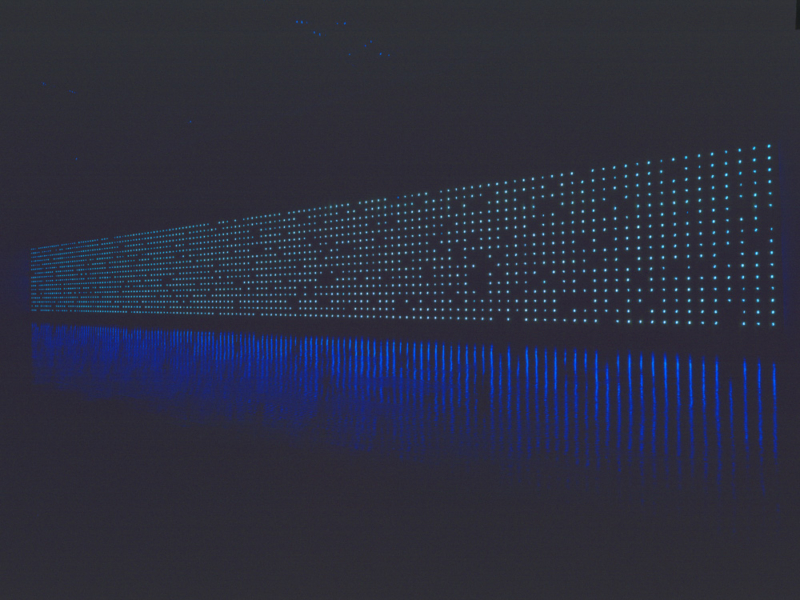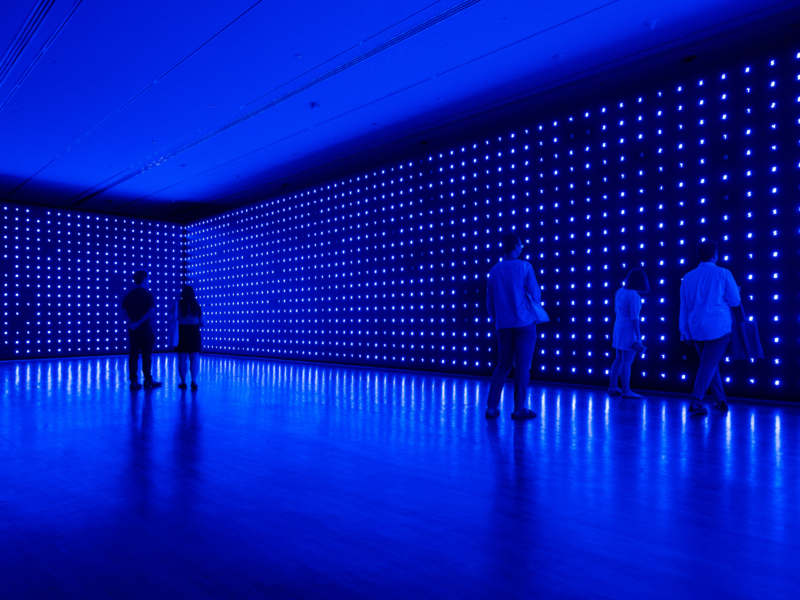Light Emitting Diode, IC, Electric wire, Light sensor.
Original installation size : 365.1 x 3579.7 x 2.5 cm
1999/2016
Collection of Domus Foundation
Installation view at Tokyo Opera City Art Gallery, 2000. Photo: Norihiro Ueno
Installation view at MCA Australia, 2016. Photo: Alex Davis
Installation view at 'Minimalism: Space. Light. Object.,' 2018
Image courtesy of National Gallery Singapore
The Counter Gadgets (LEDs) in Tatsuo Miyajima's work symbolize the radiance of human life. The Gadgets count down from nine to one, on to complete darkness without indicating "zero" and returning to nine and repeats itself. The transformation and flashing of the numbers symbolize "life" of man and the darkness of "zero" symbolizes "death".
In Buddhist Philosophy, the life of man is interpreted as the repetition of "life" and "death". In other words, "death" is not an end, but is similar to a sleep as a preparation for the "next life". Furthermore, the rhythm (Life Time) of "life" to "death", from "death" to "next life" is innate in every individual life, with individuality. It is also said that each possesses a different rhythm.
Each and every man has performed this solemn drama for hundreds and thousands of years. Such "life and death" have appeared and disappeared, disappeared and appeared throughout the world. It is beautiful as watching a sky full of glittering stars. As each and every "life" is different, "death" is never the same. Therefore, each man's "life" and "death" sparkle and resonate with others, as if they were performing a majestic and universal symphony. Miyajima considers this the beauty of "ordinary life and death" (Natural Life Time).
However, at times this solemn performance of "Natural Life Time" has been destroyed and divided - by acts of evil.
According to the calculation of Brzezinski, former national security advisor to Jimmy Carter, 167,000,000 lives have been lost in the events caused by human acts such as war, revolution and conflict in the 20th century. This figure, a terrifying number, equals to a total population of Italy, France and England of 1997. In a way, this century has been an era of "Artificial Mega Death".
"Death" of life, which has been unnaturally and unjustly caused has no individuality any longer. This "life and death" all becomes "death" in the same nature. Because the destruction and division of individual "Natural Life Time" mean that the eternal rhythm, the innate rhythm of each life, which flows from "life" to "death," and to the "next life" is disturbed. It becomes deprived "death," its eternal rhythm being disrupted and suspended in midair, not as fertile "death" with a rhythm to its "next life". This "death" has no sparkles to resonate with "life" any longer, and is deprived of its individuality. The darkness of "Artificial Mega Death" is filled up with the same nature of "death" and only the terror of suspension remains.
This work is Miyajima's attempt to question people to think about the meaning of "Artificial Mega Death" by contrasting the beauty of "Natural Life Time," a majestic and universal symphony, and the terror felt when it is suddenly destroyed.



